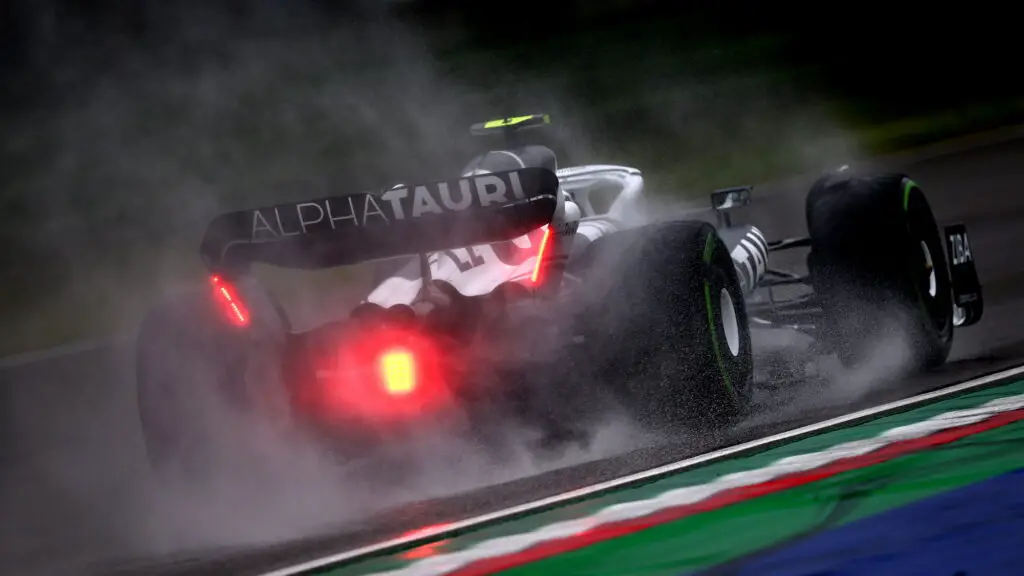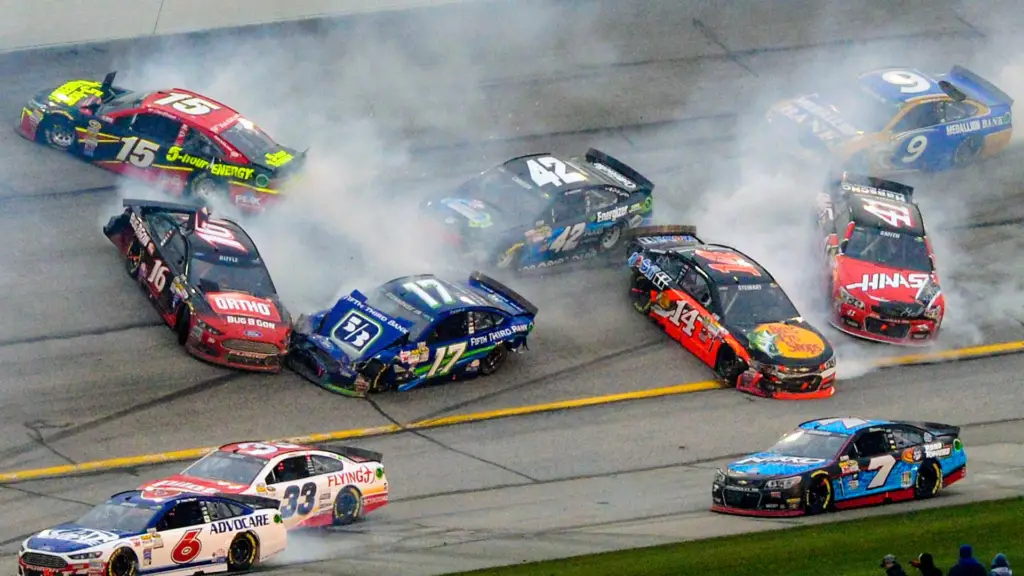In the world of motorsport, two giants (NASCAR vs F1) stand out as behemoths, each with its own fiercely dedicated fan base and a unique style of racing. On one side, we have the thunderous roar of NASCAR, where stock cars clash and barge their way around ovals and road courses, fueled by the spirit of American racing. On the other, there’s the precision and agility of Formula 1, where sleek, open-wheel machines navigate the twists and turns of circuits worldwide, embodying the pinnacle of international motorsport.
NASCAR and Formula 1 may share the same fundamental elements – four wheels, powerful engines, and elite drivers. However, they could not be more different in terms of their philosophies and execution. Each are different where car types, racing formats, financial structures, and even the very ethos that drives their competition are unique to each sport.
In this article, we will embark on a thrilling journey to explore the intricate web of disparities between these two motorsport giants. We’ll dissect the nuanced engineering behind their engines, contrast their qualifying procedures, and unravel the complexities of their scoring systems. Buckle up and join us as we unravel the fascinating world of NASCAR and Formula 1, where speed, strategy, and spectacle converge in unique and contrasting ways.
F1wordlwide.com also recomends
- F1 Terms: A Comprehensive List of Racing Terms
- The Evolution of F1 Racers: How Technology Has Shaped the Sport
- The History of Formula One Racing: From the 1950s to Today
Machines of Speed – NASCAR vs F1 Race Cars
Motorsports, a realm of speed and precision, is home to a variety of racing series, each with its unique set of rules and vehicles. Two of the most popular series globally are NASCAR (National Association for Stock Car Auto Racing) and F1 (Formula One). While both involve high-speed racing, the types of cars used in these races are quite different. Let’s explore the specifics of NASCAR and F1 race cars.
NASCAR Race Cars

NASCAR features three models of cars as nameplates in the series: the Ford Mustang, Chevrolet Camaro, and Toyota Camry. Each manufacturer designs and builds their own engines. The current generation made its debut for the 2022 Cup Series season.
The Generation 7 car has several notable changes from the Generation 6 car, including greater chassis rigidity and larger, 18-inch wheels and tires. The “Generation 7” chassis, transmissions, and bodies are new. The engines remain the same 5.86-liter V8 pushrod models used in the previous generation’s cars.
F1 Race Cars

F1 race cars are single-seat, open-cockpit, open-wheel formula racing cars with substantial front and rear wings, and an engine positioned behind the driver. The regulations are unique to the championship. Each racing team constructs their own cars.
F1 race cars are some of the fastest in the world around a racetrack, owing to very high cornering speeds achieved through the generation of large amounts of aerodynamic downforce. All vehicles have a hybrid powertrain consisting of a 1.6-liter turbocharged V6 engine and a battery-powered electric motor.
The Financial Race – NASCAR vs F1

Motorsports, a realm of speed and precision, is home to a variety of racing series, each with its unique set of rules and vehicles. Two of the most popular series globally are NASCAR (National Association for Stock Car Auto Racing) and F1 (Formula One).
While both involve high-speed racing, the financial structures of these races are quite different. Let’s explore the specifics of NASCAR and F1’s financial differences.
Annual Turnover comparison between NASCAR and F1
NASCAR’s annual revenue is +- $100 million. On the other hand, Liberty Media, the parent company of F1, generated $2.19 billion in revenue in Q1 2022.
According to various reports, it takes about $400,000 per week to run a NASCAR team over a 38-race season, totaling about $15 million in annual expenses. On the other hand, Formula 1 has a budget cap of $135 million for the 2023 season.
This cap does not include all the bits and pieces that don’t count towards the cap. In total, Red Bull spent $283.5 million to win the 2021 Drivers’ title with Max Verstappen.
Team Earnings Comparison Between NASCAR and F1
The earnings of NASCAR and F1 teams differ significantly. In NASCAR, teams spend about $15 million annually. In contrast, F1 teams spend a lot more for their 20-plus race season than NASCAR teams do over the course of their season.
For instance, Red Bull Racing spent $283.5 million to win the 2021 Drivers’ title with Max Verstappen.
Driver Salary comparison between NASCAR and F1


Driver salaries also differ between NASCAR and F1. NASCAR’s Kyle Busch earned $16.9m last season, while F1’s top-paid driver Lewis Hamilton had a salary of $40m.
On average, F1 drivers earn more money than NASCAR drivers. The highest-paid NASCAR driver is Kyle Busch, who makes a reported 16.9 million dollars after salary and sponsorships.
Denny Hamlin is a close second, making 13.1 million. One reason that NASCAR drivers make less than Formula 1 drivers is that they have much more.
Team Numbers
NASCAR boasts more teams and drivers than F1, with 36 chartered teams in the Cup Series compared to F1’s 10 teams.
NASCAR teams fields one to four drivers. Competition is diversified by allowing uncharted entries.
The Velocity of Victory – NASCAR vs F1 Speed Comparison
Motorsports, a realm of speed and precision, is home to a variety of racing series, each with its unique set of rules and vehicles. Two of the most popular series globally are NASCAR (National Association for Stock Car Auto Racing) and F1 (Formula One). While both involve high-speed racing, the speeds achieved in these races are quite different. Let’s explore the specifics of NASCAR and F1 race speeds.
NASCAR Race Speeds

In a typical NASCAR race, the top speed achieved is around 200 miles per hour. They can go from zero to 60 mph in approximately three seconds. During a race, NASCAR vehicles can reach up to 750 horsepower, whereas a regular car tops out at about 300 horsepower.
Hall of Famer Bill Elliott holds the fastest recorded time in NASCAR history. He clocked 212.089 miles per hour during a qualifying run at Talladega Superspeedway. However, after Elliott’s record run, NASCAR implemented restrictor plates on all of its cars to limit the power of the car’s engine and max out the car’s top speed.
F1 Race Speeds

F1 cars can reach speeds of up to 223 mph/360 kph during a race and can accelerate from 0-60 mph in around 2.6 seconds. On faster circuits, F1 cars can travel at average speeds of around 160 mph/257 kph. Valtteri Bottas holds the record for the fastest speed of an F1 car. He achieved this in Mexico. His recorded speed was 231.4 mph/372.5 kph.
The Engines of Speed – NASCAR vs F1
The world of motorsports is diverse and exciting, with various racing series each having their own unique characteristics. Two of the most popular are NASCAR (National Association for Stock Car Auto Racing) and F1 (Formula One). While both involve high-speed racing, the engines that power these cars are quite different. Let’s delve into the specifics of NASCAR and F1 engines.
NASCAR Engines

NASCAR cars use 90-degree pushrod V8 engines. These engines have a displacement of 358 cubic inches (5.9 liters). The cylinder bore ranges from 3.8 to 4.185 inches (97 to 106 mm), and the piston stroke varies between 3.25 to 4.5 inches (83 to 114 mm). The naturally aspirated engines use either a carburetor or electronic fuel injection system.
The power output of a NASCAR engine can range from 135 to 1,000 horsepower (101 to 746 kW), with a torque output between 253 to 783 lb⋅ft (343 to 1,062 N⋅m). For the 2022 season, NASCAR has introduced two aerodynamics/engine “packages” for NASCAR spec cars. The Superspeedway package for Talladega and Daytona includes a seven-inch spoiler and 510 horsepower restrictor plates.
F1 Engines

Formula 1 cars, on the other hand, use hybrid-powered 4-stroke piston Otto-cycle engines. F1 engines are much more technologically advanced than their NASCAR counterparts. They are powered by a four-stroke 1.6 litre V6 engine, which includes a turbocharger and hybrid electric ancillaries.
The maximum permitted RPM is electronically limited to 15,000 as of the 2021 season.
F1 engines are designed for high rotational speed, operating at up to 20,000 revolutions per minute (rpm), although they are electronically limited to 15,000 rpm as of the 2021 season. This contrasts with road car engines of a similar size, which typically operate at less than 6,000 rpm.
The power output of F1’s 2022 engines is over 1000bhp, with all manufacturers achieving similar figures5 Despite this incredible output, the power units only use around 130 liters of fuel for a Grand Prix distance of 300 kilometers.
F1 engines are significantly more expensive, costing $10.5 million compared to NASCAR’s $100,000.
The Race Before the Race – NASCAR vs F1 Qualifying Formats
The race starts before the starter waves the flag. The qualifying rounds determine the starting positions for the main race and are a crucial part of any racing event. NASCAR and F1, two of the most popular racing series globally, have distinct qualifying formats that reflect their unique racing styles and regulations. Let’s delve into the specifics of NASCAR and F1 qualifying formats.
NASCAR Qualifying Format
In NASCAR, the qualifying format has seen several changes over the years. For the 2022 season, NASCAR introduced a knockout-style format. Here’s how it works:
- The field is split into two groups based on the finishing order from the previous race.
- Each group participates in a two-hour practice and qualifying event.
- For most oval tracks, cars are separated into two groups set by the odd/even finishing order of the previous race.
- 15-minute practice sessions are followed by single-car qualifying with one lap (Two laps at Bristol, Martinsville, Dover, and Richmond).
- The top five drivers from each group advance to the final round.
- In the final round, drivers compete in a single-car, one-lap qualifier.
For six Cup Series weekends, there will be an expanded practice schedule with one more 50-minute practice.
F1 Qualifying Format
F1 uses a three-stage knockout qualifying system. Here’s how it works:
- All drivers participate in the first period, called Q1, with each trying to set the fastest time possible.
- The five drivers with the slowest lap times are eliminated at the end of Q1.
- The remaining drivers move on to Q2.
- Again, the five drivers with the slowest lap times are eliminated at the end of Q2.
- The remaining top 10 drivers compete in Q3.
- In Q3, drivers aim to set the fastest time possible to secure pole position.
The Race Day Showdown – NASCAR vs F1 Race Formats
Motorsports, a realm of speed and precision, is home to a variety of racing series, each with its unique set of rules and vehicles. Two of the most popular series globally are NASCAR (National Association for Stock Car Auto Racing) and F1 (Formula One). While both involve high-speed racing, the formats of these races are quite different. Let’s explore the specifics of NASCAR and F1 race formats.
NASCAR Race Format
NASCAR breaks the races into segments, ending with a green-and-white checkered flag and a caution period where laps continue counting. Most races have three stages.
At the end of the first and second stages (and the third, in the Coke 600), the top-10 finishers earn championship points. The stage winner gets 10 championship points and a playoff point, second gets nine points and no playoff points, third gets eight, and so on.
At the end of each race, the winner earns five playoff points and 40 championship points.
The NASCAR Cup Series playoffs have undergone numerous changes over the past 17 years since it was introduced as the Chase for the Championship back in 2004. The current format premiered in 2014 and simplified the value of winning.
The playoffs are made by full-time race winning drivers who are registered to compete for Cup Series. It’s pretty much as simple as that.
F1 Race Format
A Formula One Grand Prix takes place over a weekend i.e., on 3 days − Friday, Saturday and Sunday. Different events take place on each of these 3 days.
They are − Friday − Free Practice Sessions Saturday − Free Practice Session plus Qualifying Session Sunday − Race Day.
F1 Sprints run over 100km (in Silverstone’s case, 17 laps) and last around 25-30 minutes. It is designed to provide a short and fast-paced racing spectacle – similar to a Twenty20 cricket match – with drivers racing flat-out from start to finish without the need to pit.
They award points to the top three finishers. Three for the winner down to one point for third.
The finishing order of F1 Sprint will continue to define the grid for Sunday’s showpiece event – the Grand Prix, where the traditional format remains unchanged.
Chapter: The Points of Victory – NASCAR vs F1 Scoring Differences
In the world of motorsports, victory is not just about crossing the finish line first. The scoring systems in racing series play a crucial role in determining the champions. NASCAR and F1, two of the most popular racing series globally, have distinct scoring systems that reflect their unique racing styles and regulations. Let’s delve into the specifics of NASCAR and F1 scoring systems.
NASCAR Scoring System

In NASCAR, drivers earn points by placing in the top ten of a race stage or finishing a race. Driver points accumulate throughout the season and serve one purpose: to qualify the driver for the NASCAR playoffs.
Drivers can earn a maximum of 10 points for winning each stage and 40 points for winning the race.
They award 10 points to the stage winner. The second-highest driver earns 9 points, down to the 10th-place finisher, who earns one additional bonus point. If a driver wins both stages and the race, he/she earns a maximum of 60 points (or 70 points if they win all three stages and the race in the Coca-Cola 600).
Each finishing spot in the field earns a driver points, from a maximum of 40 points to the driver who finishes first, down to one point for the driver who finishes 40th. These points accrue over a season and determine the driver standings, as well as the owner standings.
F1 Scoring System

A points scoring system is used for each Grand Prix held over the course of the F1 season to determine the outcome of two annual championships. One for drivers (World Drivers’ Championship) since 1950, and one for constructors (World Constructors’ Championship) since 195.
The winner of each race gets 25 points, with 18 for second place and 15 if you get third spot on the podium. An extra 1 point is awarded to the driver and team who recorded the fastest lap (as long as they finished inside the top 10 points scoring positions).
F1 Sprint also awards points. So with 24 races scheduled for the 2023 season plus the sprints, there is a maximum total of 672 points available for a driver to score.
The sprint points work as follows: Position Points – 1st:8, 2nd:7, 3rd:6, 4th:5, 5th:4, 6th:3, 7th:2, and 8th:1.
Playoff System
NASCAR employs a playoff system where the top 16 drivers compete in the final 10 events, with eliminations after every three races. The final race features a showdown among the remaining four drivers to determine the champion.
The Shield of Speed – NASCAR vs F1 Safety Measures
Safety is paramount in the high-speed, high-risk world of motorsports. Both NASCAR and F1 have implemented a variety of safety measures to protect drivers, teams, and spectators. Let’s explore the specifics of NASCAR and F1 safety measures.
NASCAR Safety Measures

NASCAR has made significant strides in driver safety over the years. Here are some key safety measures:
- Focus on Driver: According to NASCAR, safety starts at the driver’s seat and builds outwards. The seat is designed to keep the driver safe during a race.
- Seat Belts: About 19 years ago, NASCAR began requiring the use of Hubbard’s Head and Neck Support (HANS) devices which continue to protect drivers today.
- Roof Flaps and Window Nets: These features are designed to prevent cars from flipping over during a crash.
- Fire Protection: NASCAR drivers wear fire-retardant suits, undergarments, shoes, and gloves to protect them in case of a fire.
- Car Design: The Generation 7 car has several notable changes from the Generation 6 car, including greater chassis rigidity and larger, 18-inch wheels and tires.
F1 Safety Measures

F1 has also made great strides in improving safety for drivers. Here are some key safety measures:
- Helmets: F1 drivers are required to wear helmets that meet stringent safety standards.
- HALO: the Halo device protects the driver from impacts through the top of the care, including roll over events.
- Fire-resistant Race Suits: F1 drivers are required to wear fire-resistant suits.
- HANS Device: Like NASCAR, F1 also requires drivers to use the HANS device.
- Survival Cell: Introduced in 1981, the survival cell is a strong structure around the cockpit designed to protect the driver.
- Safety Car: Introduced in 1993, the safety car is used to slow down the race during dangerous situations.
- Pitlane Speed Limit: Introduced in 1994, this rule limits the speed of cars in the pitlane to enhance safety.
Conclusion
While both F1 and NASCAR share a passion for racing, they are distinct in terms of race car types, financial structures, speed, engine technology, qualifying and race formats, scoring systems, playoff approaches, and attitudes towards contact. These differences contribute to the unique appeal of each series.

